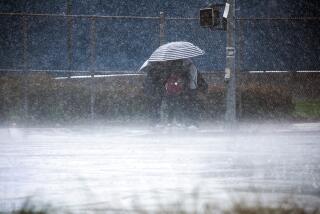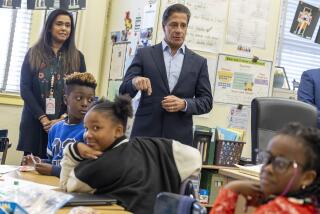Questions Remain About Year-Round Schools : Education: A variety of academic, sports and extracurricular activities have yet to be worked out by the Los Angeles Unified School District.
- Share via
With six months to go before all 649 Los Angeles schools open their classrooms year-round, many questions remain about how the district plans to coordinate a range of academic and extracurricular activities.
Administrators say they don’t know how many schools will be able to offer special courses during the eight-week winter break that runs from late December into February for students at some schools.
The district also has not settled on a schedule for winter sports such as soccer, basketball and wrestling, causing some coaches to worry about how practices and games will be scheduled when students are on semester breaks.
And some parents fear that children will swelter in classrooms without air conditioning. The district has installed air conditioning at 154 multitrack campuses where classes will begin July 9 and plans to install it in all schools converting to multitrack schedules within a year.
Multitrack schedules permit schools to squeeze in one-third more students by dividing them into groups that attend school on staggered schedules, with one group on vacation at all times.
“This is going to happen very quickly and of course there are concerns,” said Philip Nassief, director of instruction for the senior high division of the Los Angeles Unified School District. “The district is looking at each problem. We don’t want to make hasty decisions.”
The board is expected today to adopt a year-round school calendar that standardizes vacation times for most students. It is called the “90/30 common calendar” because it gives students two 90-day semesters with 30 days off at the end of each, plus two weeks off for Christmas vacation.
About 170 of the district’s 645 schools already are open year-round, most of them on multitrack schedules, and 34 more may be forced into multitrack programs because they are so overcrowded.
Students on a multitrack system would attend school for 163 days, with an additional 40 minutes of instruction each day. Under this schedule, classes would start July 8 and “summer school” could be offered for 30 days starting July 1, 1991, or Jan. 2, 1992.
Students on a single-track system would attend school for 180 days, starting Aug. 19. There would be an eight-week winter break beginning Dec. 23, 1991, and a seven-week summer break beginning June 30, 1992.
Converting to year-round schools requires fine-tuning everything from PTA meetings and yearbook production to student council meetings, bus rides and advanced placement classes. District officials say YMCAs are drawing up special day-care programs and organizations that run summer camps are looking at the possibility of converting their sites for winter use.
And local businesses have been quick to adjust to the new schedules, gearing up their own programs to hire high school students all year instead of just during the summer, educators say.
In the past, some parents worried that their children would be scattered across different tracks, eliminating the possibility of family vacations. But educators say that traditional summer vacations--the legacy of an agrarian society when children were needed to help harvest crops--is outmoded and that some parents actually prefer the new program.
“One mother of eight wanted all the kids on different tracks so she’d have someone home at all times to help out with the smaller children,” said Antonio Garcia, principal of Huntington Park High School, which has been on a year-round, multitrack system for eight years.
Interviews with principals at schools that have already launched year-round programs indicate that flexibility among parents, teachers and administrators is key to success.
“Once you get over the perception that year-round is negative, then you can get some work done,” says Howard Lappin, principal of Foshay Junior High School in Central Los Angeles. Lappin, who worked at year-round campuses in Southeast Los Angeles for almost a decade before coming to Foshay in July, says schools have peppered him with requests for information.
Lappin dismisses concerns that high school sports suffer under a year-round program, noting that South Gate High School won the city football championships on a year-round schedule.
But South Gate is a multitrack school and coordination of winter sports is still unresolved for single-track schools that have an eight-week winter break.
“This is going to be a problem for 90% of the schools; we don’t know what we’re going to do with those programs,” says Hal Harkness, director of senior high school athletics.
Harkness said he has scheduled a Jan. 22 meeting with coaches but dispelled rumors that any sports would be cut, saying that “there are no plans to eliminate anything.”
He speculated that the district could either move those sports into a different season, which might mean students would be forced to choose between, say, baseball and soccer. Conversely, the district may be able to work out bus transportation and supervision that would allow coaches to continue drilling students through the winter break.
Lappin says students at year-round schools have already demonstrated a willingness to come to school during their breaks to work on extracurricular activities.
“Our academic pentathlon is made up of kids on all tracks and I find the kids who are involved are more than happy to come in on their breaks,” Lappin said. He adds that the same is true of advanced placement classes in which students earn credit for college.
Indeed, several principals say year-round schools are better because they reinforce lessons throughout the year instead of giving students a long summer to forget what they have learned. Additionally, district officials say they plan to offer six-week “mini-courses” during winter and summer breaks that will offer everything from remedial algebra to English as a second language.
Educators say that scheduling such mini-courses during winter break would give struggling students an opportunity to review what they learned in the fall and gifted students an opportunity to get a head start on the spring semester through enrichment classes.
“If a kid fails the first part of algebra, he has an opportunity to make it up instead of going straight into the second semester,” says Joyce Peyton, a district coordinator for year-round schools.
But officials caution that mini-classes will require a minimum enrollment of 32 students and probably will not be offered at every school.
“There is a limit on the number of dollars the state gives us to run summer and inter-session classes and we don’t know what the demand will be,” Nassief said.
Parents have already raised concerns that the district may not offer enough remedial and enrichment classes during these semester breaks.
“I’ve heard parents at multitrack schools complain that they can’t get their child into these classes because there are none available,” said Barbara Topkis, president of the Parent-Teachers Assn. that covers all of Los Angeles Unified except the San Fernando Valley.
A 1988-89 district evaluation of year-round schools was mixed, concluding that some students had lower test scores, while others scored higher. The report also found less teacher burnout than at traditional schools and more student burnout at the senior high level.
“Sometimes kids spend too much time at school and you have to yell at them and say go away,” Lappin says.
The study found that the average verbal Scholastic Aptitude Test scores for year-round students was much lower than at traditional schools, and somewhat lower in math. But it also cautioned against drawing conclusions, pointing out that schools convert to year-round schedules because of overcrowding and have generally been located in poor and minority areas where students often score lower.
More to Read
Sign up for Essential California
The most important California stories and recommendations in your inbox every morning.
You may occasionally receive promotional content from the Los Angeles Times.













